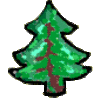Plants: Mostly diocious, rarely monocious.
Ovulate cones: Compound, small, greenish, herbaceous, spiral or decussate phyllotaxis, ovules many to few; each subtended by a bract, inserte at a small primordium which later forms the epimatium, erect (Microstrobus, Phyllocladus) or ± inverted by the epimatium; epimatium a one-sided outgrowth which covers the mature ovule (except in Microstrobus and Phyllocladus); mature seeds mostly not enclosed in the cone, often large, associated with fleshy parts (epimatium, peduncle or cupule), often colourfull (zoochorous; birds, mammals such as bats).
Pollen cones: Simple (often clustered, catkin-like); male sporangiophores simple, hyposporangiate, with two sporangia; pollen with two, three of one ring-like air-bladders (except Saxegothaea without air-bladders).
Leaves: mostly simple needles, with one median or with multiple vascular bundles that originate from basal bifurcations; in Phyllocladus the leaves are reduced and scale-like, with assimilative phylloclades (leaf-like shoots).
Podocarpaceae Endl. 1847
nomenclatorial act:
subsequent publication
Page:
136
diagnosis:
systematic position:
Pinopsida, Pinales
Classification:

Add new comment